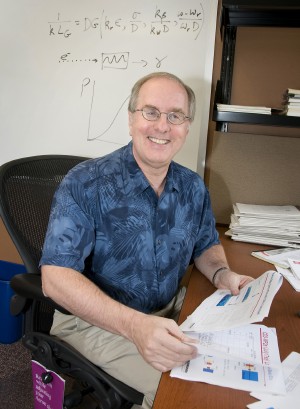Samuel Krinsky, a physicist at the U.S. Department of Energy's Brookhaven National Laboratory, has won thee 2008 Free Electron Laser (FEL) Prize. Sponsored by the FEL Conference, which was held this year in Gyeungju, Korea, the prize consists of an award citation, a plaque, and approximately $3,000.

Krinsky is the fourth Brookhaven Lab scientist to receive the FEL Award. Li Hua Yu received it in 2003; Vladimir Litvinenko shared the prize with Hiroyuki Hama of Tohoku University, Japan, in 2004; and Ilan Ben-Zvi was awarded the prize in 2007 along with James Rosenzweig of the University of California-Los Angeles. Each of the recipients was given the honor "in recognition of his outstanding contributions to FEL science and technology."
An FEL is a research tool that combines the intensity of lasers and the broad wavelength range of synchrotrons, and it is useful for studying a wide variety of materials and chemical reactions. A synchrotron is an accelerator that produces various wavelengths of light for the investigation of materials at the atomic level. Brookhaven Lab is home to the National Synchrotron Light Source (NSLS) and is in the process of designing a new light source, the NSLS-II, which will help to meet future scientific challenges.
"I am honored to receive the FEL Prize," Krinsky said. "The field of FELs provides challenging theoretical questions and exciting applied goals. I have greatly enjoyed collaborating on FEL theory and development with Brookhaven Lab's Li Hua Yu and Ilan Ben-Zvi and Bob Gluckstern of the University of Maryland."
Over the last 25 years, Krinsky and colleagues have contributed significantly to developing two types of FELs used in scientific research: the self-amplified spontaneous emission free electron laser (SASE FEL), and the high gain harmonic generation free electron laser (HGHG FEL). In the SASE process, the light the laser emits for experiments starts from noise, or random signals. The SASE FEL can generate very short high-intensity pulses of x-rays, making possible studies of time-dependent processes important in the physical and life sciences. In the HGHG process, which was initiated at Brookhaven Lab, the output light starts from fast-moving electrons interacting with a seed laser that shifts the light to a higher frequency and makes it more coherent, meaning electrons move in a coordinated way to emit light. The intense light of the HGHG FEL reveals the fine details of atomic reactions inside materials and the very fast motions of molecules in chemical reactions, all with unsurpassed precision.
Since the mid-1980s, Krinsky has worked on the theory of the SASE FEL, providing important information on how the process of making light from "noise" begins and characterizing the statistical properties of generated x-rays. He also provided crucial insights about the functioning of the electron beam and the focusing properties of the magnetic field in the device. SASE FELs are currently under construction in the U.S., Europe and Japan.
In the 1990s, Krinsky and colleagues from Brookhaven, in collaboration with Argonne National Laboratory, initiated proof-of-principle experiments for the HGHG FEL at Brookhaven Lab. In 1999, the Brookhaven-Argonne team verified the theoretical foundation of the HGHG FEL operating in the infrared region of the light spectrum. In 2002, the technique was further developed to enable the HGHG FEL at Brookhaven to produce shorter wavelength light, in the deep ultraviolet spectral region. At present, work is ongoing in the U.S. and Europe to develop HGHG FEL facilities.
Samuel Krinsky earned a bachelor's degree in physics from the Massachusetts Institute of Technology in 1966 and a Ph.D. in high-energy theory from Yale University in 1971. He joined Stony Brook University's Institute of Theoretical Physics in 1971, and then came to Brookhaven Lab in 1973 as in assistant physicist. He moved through the ranks to become a senior physicist in 1985, Head of the NSLS Accelerator R&D from 1985 to 2001, and Deputy Chair of the NSLS from 1986 to 2001. He was also Manager of the Laboratory's FEL Program from 1999 to 2002. In January 2008, he became Accelerator Physics Group Leader in the NSLS-II Project.
A Fellow of the American Physical Society, Krinsky was responsible for the design and commissioning of the NSLS x-ray storage ring. In 1989, he was among nine Brookhaven Lab scientists and engineers who shared the R&D 100 Award, given by R&D Magazine to recognize the top 100 technological achievements of the year, for the invention of the real-time-harmonic closed-orbit feedback system. The system was devised for the NSLS to stabilize the orbit of the electron beam as it circulates around the synchrotron. Krinsky is also a recipient of Brookhaven Lab's 1994 Distinguished Research & Development Award.